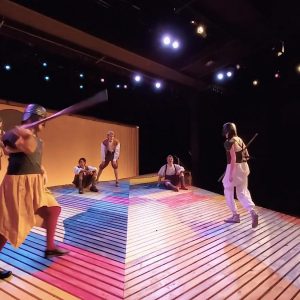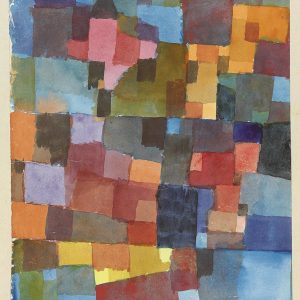Lovers and madmen have such seething brains,
Such shaping fantasies, that apprehend
More than cool reason ever comprehends.
— William Shakespeare, A Midsummer Night’s Dream
The play opens on Oct. 5
If the merriment being experienced by the actors and crew in rehearsing the show is any indication, audiences will love CSU’s upcoming production of A Midsummer Night’s Dream by William Shakespeare, directed by long-time theatre professor Walt Jones. The two-weekend run opens on Friday, Oct. 5 in the University Theatre at the University Center for the Arts.
William Shakespeare’s classic, first performed around 1596, is one of the bard’s most beloved plays. For centuries, audiences have enjoyed this comic fantasy about four lovers who find themselves bewitched by fairies and suffering strange love experiences. Portraying the events surrounding the marriage of Theseus to Hippolyta, an Athenian weaver who is transformed into an ass-headed monster, and the antics of Oberon and Titiana, the fairy king and queen, A Midsummer Night’s Dream is an artful examination of love, jealousy, and marriage and is a delightful evening, full of wit and magical surprises.
The interpretations of A Midsummer Night’s Dream are endless. “I’ve found that the best approach is to just go with my own instincts,” Jones says. “If I think it is funny, I hope people will come along for the ride.”

CSU production of William Shakespeare's A Midsummer Night's Dream, July 8, 2009
New set is a welcome challenge
It’s been ten years since CSU Theatre last staged the renowned play, and the 2019 version is quite kinetic—full of even more movement, pratfalls, and stage combat than before, all made more challenging due to the steep surface of the set.
In order to navigate the steeply raked stage (a surface that slopes up and away from the audience), CSU theatre alum Bryan Connolly (B.A. Theatre, ’13) is leading the choreography efforts with assistance from senior theatre major Kalie Lanik. Connolly also choreographed the stunts in last semester’s production of One Man, Two Guvnors.
“This is not easy stuff, but the cast is embracing the challenging slope as it allows for tricks, trap doors, and dramatic effect,” says Jones. “There’s obvious magic in the show—we’re not trying to hide what we’re doing, really, but it still comes off as charming and magical.”
The production feels current
The surface is saturated with gorgeous, modern lighting that takes inspiration from a Paul Klee color palette; an 8-foot moon presides over the shenanigans. The costumes are purposefully undefinable as being from a specific period as Renaissance elements are paired with t-shirts. The sound design includes scary forest elements like howling wolves, combined with a soundtrack that is both gentle and sometimes boisterous; selections ranging from The Fairy Queenopera by Henry Purcell to a Paul Simon song.
“We’re pulling whatever we need from wherever we need to pull it. I think the audience will find all of the technical aspects interesting and current,” states Jones.
Jones has strived to make the Shakespearean tongue current and contemporary as well with nothing of antiquity in the presentation. Patrons seeing a Shakespeare production for the first time might feel like they’re hearing another language during the first scene but will quickly fall into the rhythm and pace. “The cast isn’t treating it like it is old English and are not doing accents,” says Jones, who has had the students examine a concordance to confirm that they know what the phrases mean.
“CSU Theatre graduated a whole bunch of ringers last year, so 80% of the cast are sophomores and freshman,” explains Jones about why the audience will see so many new faces on stage. “It’s time for them to stake their claim, and they’re doing so with the Shakespeare comedy!”
Fast-paced play
Audiences will appreciate that even in Shakespeare’s time, his plays were almost never performed to full length. The company would cut what they wanted and blame the audience or censorship by the Master of the Revels, an officer of Lord Chamberlain. Jones explains that he didn’t want the production bogged down by length and “cut out stuff that makes the interpretation hard. It makes watching it easy.” CSU’s “Midsummer” runs about an hour and a half.
 With a host of jealous characters and acrimonious interactions, Pat Benatar’s “Love is a Battlefield” has become the cast’s backstage inspiration and theme. “They took to [the theme] voraciously,” says Jones, smiling. “Even before you add the blocking, everyone is at odds with each other, and they’ve taken the physical and verbal fighting to new lengths.”
With a host of jealous characters and acrimonious interactions, Pat Benatar’s “Love is a Battlefield” has become the cast’s backstage inspiration and theme. “They took to [the theme] voraciously,” says Jones, smiling. “Even before you add the blocking, everyone is at odds with each other, and they’ve taken the physical and verbal fighting to new lengths.”
“We’re having a good time—I hope you’ll join us!”
Ticket information
The Colorado State University School of Music, Theatre, and Dance presents A Midsummer Night’s Dream by William Shakespeare. Performances take place on October 4, 5, 10, 11, 12 at 7:30 p.m., with 2 p.m. matinees on October 6 and October 13. All performances take place in the University Theatre at the University Center for the Arts, located at 1400 Remington Street. Tickets are available at csuartstickets.com or at the box office one hour before curtain.


